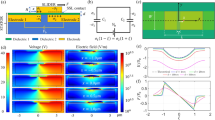Abstract
In this paper, detailed theoretical analysis of micromechanical Transresistance oscillator is presented. Analytical expressions are derived for the frequency pulling, critical transimpedance, maximum negative resistance, and start-up time constant of the Transresistance oscillator circuit which are useful for the design of micromechanical oscillators. These results are then used to study the frequency stability of Transresistance oscillator circuit and compare its operating conditions with that of the Pierce oscillator circuit which is widely used in micromechanical oscillators. The results conclusively show that the Transresistance oscillator has less start-up problems and better frequency stability than the Pierce oscillator. These results are then verified with a well-established circuit theory that compares the phase-frequency plots of the Pierce and Transresistance oscillator.














Similar content being viewed by others
References
Advanced SiResTM silicon MEMS technology expected to replace traditional quartz resonators. SiTime Corporation. Retrieved October 2006, from http://www.sitime.com/news/releases/041006_replace.htm.
Seshia, A. A., Low, W., Bhave, S. A., Howe, R. T., & Montague, S. (2002). Micromechanical Pierce Oscillator for Resonant Sensing Applications: Proceedings of the Modeling and Simulation of Microsystems Conference, San Juan, Puerto Rico (pp. 162–165).
Nguyen, C. T. C., & Howe R. T. (1999). An integrated CMOS micromechanical resonator high-Q oscillator. IEEE Journal of Solid State Circuits, 4(4).
Lee, S., & Nguyen, C. T. C. (2003). Influence of Automatic Level Control on Micromechanical Resonator Oscillator Phase Noise: Proceedings of the 2003 IEEE International Frequency Control Symposium and PDA Exhibition.
Lee, S., & Nguyen, C. T. C. (2004). Mechanically-Coupled Micromechanical Resonator Arrays for Improved Phase Noise: Proceedings of the IEEE Int. Ultrasonics, Ferroelectrics, and Frequency Control 50 th Anniversary Joint Conference (pp. 280–286.
Lin, Y. W., Lee, S., Li, S. S., Xie, Y., Ren, Z., & Nguyen, C. T. C. (2004). Series-resonant VHF micromechanical resonator reference oscillators. IEEE Journal of Solid State Circuits, 39(12), 2477–2491. doi:10.1109/JSSC.2004.837086.
Kaajakari, V., Koskinen, J. K., & Mattila, T. (2005). Phase noise in capacitively coupled micromechanical oscillators. IEEE Transactions on Ultrasonics, Ferroelectrics, and Frequency Control, 52(12), 2322–2331. doi:10.1109/TUFFC.2005.1563277.
Nguyen, C. T. C. (2001). A 10-MHz micromechanical resonator pierce reference oscillator for communications (pp. 1094–1097). Digest of Technical Paper, Transducers’01, Germany.
Frerking, M. E. (1978). Crystal oscillator design and temperature compensation. New York: Van Nostrand Reinhold.
Matthys, R. J. (1983). Crystal oscillator circuits. New York: Wiley.
Vittoz, E. A., DeGrauwe, M. G. R., & Bitz, S. (1988). High-performance crystal oscillator circuits: theory and application. IEEE Journal of Solid State Circuits, 23(3), 774–783. doi:10.1109/4.318.
Varsovia, J. (1996). Design guidelines for quartz crystal oscillators. STATEK Corporation, 18th Piezoelectric Devices Conference.
Palaniapan, M., & Khine L. (2006). Nonlinear behavior of SOI free–free micromechanical beam resonator. 20th Eurosensors, Sweden, 17–20 September 2006.
Galliou, S., Sthal, F., Gufflet, N., & Mourey, M. (2003). Predicting phase noise in crystal oscillators : Proceedings of the 2003 IEEE International Frequency Control Symposium and PDA Exhibition.
Razavi, B. (1996). A study of phase noise in CMOS oscillators. IEEE Journal of Solid-State Circuits, 31(3), 331–343.
Acknowledgments
The authors would like to acknowledge the financial support from NUS FRC grant No: R-263-000-315-112/101 to accomplish this research work.
Author information
Authors and Affiliations
Corresponding author
Appendices
Appendix 1: Derivation for circuit impedance
From Fig. 5, Z m can be replaced by a test voltage source (V T) to derive Z c as follows.
From Fig. 15, the following two equations can be obtained.
Z c from (9) can be derived by combining and rearranging (27) and (28) to make the circuit impedance (V T/I T) the subject.
Appendix 2: Derivation for maximum negative resistance
From (10), the real part of Z c can be simplified in terms of N and D as follows:
where, \( N = - (r_{\text{m}} - R_{\text{i}} - R_{\text{o}} ) \) and \( D = \omega^{2} C_{\text{a}}^{2} (r_{\text{m}} - R_{\text{i}} - R_{\text{o}} )^{2} + 1 \)
To find −Re(Z c)max, Re(Z c) has to be differentiated with respect to r m and equated to zero as follows:
where, \( N' = - 1 \) and \( D' = 2\omega^{2} C_{\text{a}}^{2} (r_{\text{m}} - R_{\text{i}} - R_{\text{o}} ) \)
The optimum r m at Point X can be derived by rearranging (30) to make r m the subject.
The −Re(Z c)max of (12) is derived by combining (31) and (10).
Rights and permissions
About this article
Cite this article
Wong, T.S.A., Palaniapan, M. Micromechanical oscillator circuits: theory and analysis. Analog Integr Circ Sig Process 59, 21–30 (2009). https://doi.org/10.1007/s10470-008-9242-1
Received:
Revised:
Accepted:
Published:
Issue Date:
DOI: https://doi.org/10.1007/s10470-008-9242-1





